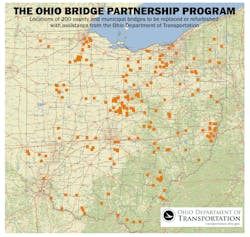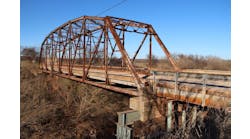If you’re a county engineer in Ohio and you need a bridge fixed, the Ohio Department of Transportation (ODOT) is coming to the rescue.
Beginning this summer, ODOT will launch the Ohio Bridge Partnership Program (OBPP), a $120 million, first-of-its-kind effort in the state, to fix up county and municipal bridges across Ohio.
The OBPP has been in the works since Gov. John Kasich took office in 2011. While Ohio’s network of 44,000 bridges (second in volume only to Texas) carried an above-average national rating, “we’re not satisfied with just that,” said Steve Faulkner, ODOT press secretary. “We want to try to do a little bit more.”
According to Fred Pausch, executive director of the County Engineers Association of Ohio (CEAO), there are 5,700 structurally deficient or functionally obsolete county bridges in the state at present. “It’s kind of a catch-up game in Ohio right now for county bridges,” Pausch told ROADS & BRIDGES.
In total, ODOT hopes to use the mechanisms of the OBPP to repair or replace 200 county bridges in calendar years 2014 through 2016.
Saving up
Initially facing a $1.6 billion construction budget deficit, the incoming ODOT administration has found ways to tighten its belt over the last several years, freeing up an extra $600 million, according to Faulkner. With that surplus built up, the department was able to set aside the $120 million for this major undertaking.
“This is the first time ODOT has taken a proactive step to get local bridges in local communities repaired, replaced and safer for motorists,” said Faulkner.
All OBPP design and construction will be completely funded by ODOT, with no local match required.
Thirty bridges have been tabbed for the first year of the program, with ODOT aiming for completion by the end of 2014. The agency is handling bridge selection itself, with substantial input from the various county engineers. “We’re looking at bridges in close proximity to each other,” Faulkner told ROADS & BRIDGES, “and we’re hoping to work multiple bridges under one contract.” The agency plans to have crews working on bridges in multiple regions simultaneously to help speed up the process.
Bridges must meet the following criteria to be eligible for the OBPP:
- They must meet the federal bridge definition, having a span greater than 20 ft long;
- They must be locally owned;
- They must be recognized as structurally deficient under the federal definition;
- They must currently be open and carrying vehicular traffic; and
- They cannot be currently funded by any other sources, such as the Ohio Public Works Program and the County Capital programs.
ODOT has its own formulas for prioritizing which bridges need to be repaired or replaced first, largely based on bridge ratings. Proximity will also be taken into consideration: “For instance,” said Faulkner, “if you have six bridges in a two-county area, can we bundle those bridges together and seek one contract to have them all repaired and replaced?”
ODOT will oversee the letting of bids and selection of contractors throughout the entirety of the OBPP program.
Helping your neighbors
Morrow County north of Columbus is home to six of the first 40 OBPP bridges, the largest percentage of any county. The rural county had a population just below 35,000 at the 2010 census, and faces many of the challenges inherent to small counties. “My capital improvements budget for bridges is sometimes $300,000 a year,” Morrow County Engineer L. Randy Bush told ROADS & BRIDGES. “When I first started as county engineer, for $300,000 I could maybe replace or fix three bridges that are 30-40 ft long. Now with $300,000, if you’re lucky you might get one bridge built.”
According to Bush, Morrow County currently has “11 or 12 bridges closed right now, and without this program, we’d potentially have a lot more over the next few years.” There are a total of 170 federal bridges in Morrow County; under the auspices of the OBPP, 29 of those are ultimately scheduled for repair or replacement.
ODOT engineers began working with Bush in December to get the ball rolling, determining parameters for the new bridges—such as minimum width and ideal load rating—as well as project scheduling and budgets. Morrow County crews did go out to the individual sites with ODOT-hired survey crews to help them get the lay of the land.
At press time, the state was preparing to put the first jobs out for bid. Faulkner told ROADS & BRIDGES that ODOT hopes to begin construction on the first sets of bridges this July.
“This is a tremendous program, and it’s going to give a lot of relief to Morrow County,” Bush said.
“We want to be good neighbors and partners with those in our local communities to improve the safety of our infrastructure system,” Faulkner said.



